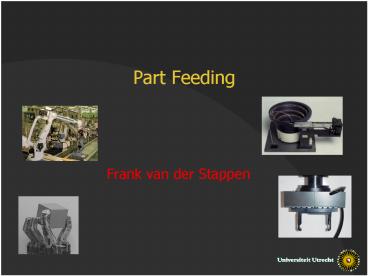Part Feeding - PowerPoint PPT Presentation
1 / 42
Title:
Part Feeding
Description:
Anthropomorphic robot arms (accompanied by advanced sensory ... En un momento dado...: [Johan Cruyff, FC Barcelona, 73-78] Only one possible orientation! ... – PowerPoint PPT presentation
Number of Views:48
Avg rating:3.0/5.0
Title: Part Feeding
1
Part Feeding
- Frank van der Stappen
2
Part Feeding
3
Conventional Manipulation
- Anthropomorphic robot arms (accompanied by
advanced sensory systems) performing
pick-and-place operations.
4
Conventional Manipulation
- Anthropomorphic robot arms/hands advanced
sensory systems - expensive
- not always reliable
- complex control
5
RISC
- Simplicity in the factory Whitney 86 instead
of ungodly complex
robot hands Tanzer Simon 90. - Reduced Intricacy in Sensing and Control Canny
Goldberg 94 - simple planable physical actions, by
- simple, reliable hardware components
- simple or even no sensors.
6
Part Feeding
- Feeders based on various actions push, squeeze,
topple, pull, tap, roll, vibrate, wobble, drop,
Parts Feeder
7
Feeding by pushing
- Rectangle can be oriented by 2 push actions.
- Result of push computable from geometry.
45?
8
Pushing
- Polygonal part with n vertices
- Center of mass
- No friction
- Push continues until part stabilizes
9
Pushing
- Part starts to rotate in clockwise direction
(with respect to the pushing jaw)
10
Pushing
- and continues to rotate until
11
Pushing
- it stabilizes on a stable edge.
12
Pushing
- Distance from center of mass to jaw decreases
during the rotation.
13
Pushing
- Part starts to rotate in counterclockwise
direction (with respect to the pushing jaw)
14
Pushing
- and continues to rotate, even through unstable
edges, until
15
Pushing
- it stabilizes on a stable edge.
16
Pushing
- Distance from center of mass to jaw decreases
during the rotation.
17
Pushing
- Unstable equilibrium no rotation but any
perturbation will lead to rotation.
18
Radius Function
- Links every orientation to the distance from the
center of mass to the tangent line with that
orientation.
f
19
Radius Function
- Part rotates to decrease the distance to the
(supporting line of) the jaw, which is tangent to
the part during pushing.
r(f)
f
initial orientation
20
Radius Function
- Part rotates to decrease the distance to the
(supporting line of) the jaw, which is tangent to
the part during pushing.
r(f)
f
final orientation
21
Radius Function
- Part rotates to decrease the distance to the
(supporting line of) the jaw, which is tangent to
the part during pushing.
r(f)
f
22
Radius Function
- Part rotates to decrease the distance to the
(supporting line of) the jaw, which is tangent to
the part during pushing.
r(f)
f
23
Push Function
r(f)
- Links every initial orientation of the part to
its final orientation after pushing.
f
f0
p(f)
f0
f
f0
24
Radius and Push Function
25
Oblivious Plans
Actual orientation of part is unknown at any
stage. Objective reduce number of possible
orientations of the part with every application
of the jaw.
Reorientation of jaw and push maps two
orientations of the part onto one.
26
Push Diagram
- Can we orient a polygonal part with n
vertices?Can we reduce the number of possible
orientations to just 1, regardless of the initial
orientation?
Polygonal partpush function has n steps, and no
ramps.
p(?)
?
27
Push Actions
- Distinguish
- Left half-step part rotates clockwise into
stable orientation. - Right half-step part rotates counterclockwise
into stable orientation.
p(?)
?
28
Push Plan
- Let a be the length of the longest right
half-step, and a-µ be larger than the length of
the second largest right half-step. - Idea Repeatedly push and reorient by a-µ.
p(?)
a
?
29
Plan Execution
- Initially Any orientation is possible.
p(?)
?
30
Plan Execution
- PushPart settles in stable orientations.
p(?)
?
31
Plan Execution
- After pushDiscrete set of possible orientations.
p(?)
?
32
Plan Execution
- Reorient by a-µNew set of possible orientations.
p(?)
?
a-µ
33
Plan Execution
- PushPart settles in stable orientations.
p(?)
?
34
Plan Execution
- After pushSmaller discrete set of possible
orientations.
p(?)
?
35
Plan Execution
- Reorient by a-µNew set of possible orientations.
p(?)
?
a-µ
36
Plan Execution
- PushPart settles again in stable orientations.
p(?)
?
37
Plan Execution
- After pushYet smaller discrete set of possible
orientations.
p(?)
?
38
Plan Execution
- Reorient by a-µNew set of possible orientations.
p(?)
?
a-µ
39
Plan Execution
- PushPart settles in stable orientation.
p(?)
En un momento dadoJohan Cruyff, FC Barcelona,
73-78 Only one possible orientation!
?
40
Parallel-Jaw Grippers
- Every 2D part can be oriented by a sequence of
push or squeeze actions. - Shortest sequence is efficiently computable
Goldberg 93.
41
Feeding with Fences
- Every 2D part can be oriented by fences over
conveyor belt. - Shortest fence design
efficiently
computable
Berretty, Goldberg,
Overmars, vdS 98.
42
Feeding by Toppling
- Shortest sequence of pins and their heights
efficiently computable
Zhang,
Goldberg, Smith, Berretty, Overmars 01.































